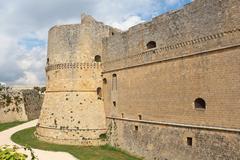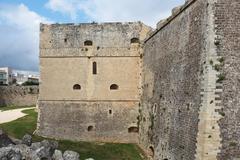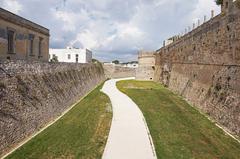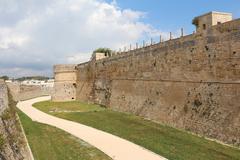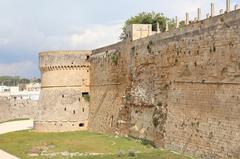
Castello Aragonese in Otranto: Visiting Hours, Tickets, and Historical Insights
Publication Date: 18/07/2024
Introduction to Castello Aragonese
Contents Overview
- Introduction
- Historical Background
- Early Fortifications and Byzantine Influence
- Norman Conquest and Medieval Expansion
- The Shadow of Ottoman Invasion
- Aragonese Reconstruction and Modern Era
- Visitor Information
- Visiting Hours
- Ticket Prices
- Visitor Guidelines
- Travel Tips and Nearby Attractions
- Travel Tips
- Nearby Attractions
- Conclusion
- FAQ
Historical Background
Early Fortifications and Byzantine Influence
The first fortifications on the site likely date back to the Roman era, strategically positioned to guard the vital harbor of Otranto, a crucial link between the East and West. Following the fall of the Roman Empire, Otranto, like much of Southern Italy, came under Byzantine rule. The Byzantines, recognizing the strategic importance of the city, further strengthened the existing fortifications, laying the groundwork for the castle that stands today. These early defenses likely consisted of simple walls and towers, forming the nucleus of the later, more elaborate structure.
Norman Conquest and Medieval Expansion
In the 11th century, the Normans, a powerful force in medieval Europe, conquered Southern Italy, wresting control from the Byzantines. Under Norman rule, Otranto experienced a period of growth and prosperity, becoming a significant port for trade and cultural exchange. The Normans, known for their military prowess and architectural achievements, undertook significant expansions of the existing Byzantine fortifications. They added a moat, ramparts, and cylindrical towers, characteristic of Norman military architecture. These additions significantly enhanced the castle’s defensive capabilities, transforming it into a formidable stronghold.
The Shadow of Ottoman Invasion
The 15th century marked a turning point in the history of Castello Aragonese and the city of Otranto. In 1480, the Ottoman Empire, at the height of its power, launched a massive invasion of Otranto. The city, despite its fortifications, was ill-prepared for the scale of the Ottoman assault. After a 15-day siege, the Ottomans, led by Gedik Ahmed Pasha, captured Otranto in one of the most brutal episodes in the city’s history.
The Castello Aragonese, despite its defenses, eventually fell to the Ottomans. The invaders, enraged by the city’s resistance, massacred a significant portion of the population, an event that sent shockwaves throughout Europe. The Martyrs of Otranto, 800 citizens who refused to renounce their Christian faith, were executed on the hill near the castle, becoming a poignant symbol of the city’s resilience and a testament to the brutality of the Ottoman conquest.
Aragonese Reconstruction and Modern Era
Following the Ottoman conquest, Otranto remained under Ottoman rule for a year before being recaptured by Aragonese forces in 1481. The recapture of Otranto marked the beginning of a new chapter for the city and its castle. The Aragonese, recognizing the importance of securing Otranto against future threats, undertook a major reconstruction of the castle.
Under the direction of the Aragonese architect Francesco di Giorgio Martini, the castle underwent significant modifications. The medieval structure was reinforced and adapted to the evolving nature of warfare, incorporating features like angled bastions and artillery platforms designed to withstand cannon fire. These additions, while serving a practical military purpose, also significantly altered the castle’s appearance, giving it the distinctive profile we see today.
Over the following centuries, the Castello Aragonese continued to play a vital role in the defense of Otranto, witnessing periods of peace and conflict. As the threat of invasion receded, the castle gradually lost its military significance, eventually being used as a prison and later as a private residence.
A Legacy Etched in Stone
Today, the Castello Aragonese stands as a proud symbol of Otranto’s enduring spirit. Its weathered walls and imposing towers whisper tales of ancient battles, foreign invasions, and the courage of those who defended its ramparts. No longer a bastion against invaders, the castle has been transformed into a cultural hub, hosting exhibitions, events, and offering visitors a glimpse into its captivating past.
Visitor Information
Visiting Hours
The Castello Aragonese is open to visitors from Monday to Sunday, with varying hours depending on the season:
- Summer (June to September): 9:00 AM - 8:00 PM
- Winter (October to May): 9:00 AM - 6:00 PM
Ticket Prices
- Adults: €10
- Children (ages 6-12): €5
- Children under 6: Free
- Group Discounts: Available for groups of 10 or more
Visitor Guidelines
- Photography is allowed, but flash and tripods are prohibited.
- No food or drinks are allowed inside the castle.
- Guided tours are available in multiple languages.
Travel Tips and Nearby Attractions
Travel Tips
- Wear comfortable shoes as the castle grounds can be uneven.
- Visit early in the morning to avoid crowds.
- Check the weather forecast and bring appropriate clothing.
Nearby Attractions
- Otranto Cathedral: Famous for its stunning mosaics and the Chapel of the Martyrs.
- Port of Otranto: Enjoy a leisurely stroll and take in the scenic views.
- Alimini Lakes: Perfect for nature lovers and bird watchers.
Conclusion
As you wander through its ancient gateways and climb its towers, remember that you are walking through centuries of history, each stone bearing witness to the ebb and flow of civilizations that have shaped the Mediterranean world. The Castello Aragonese is not just a monument; it is a living testament to Otranto’s rich and resilient heritage. Don’t miss the opportunity to explore this remarkable fortress and immerse yourself in its captivating past.
FAQ
What are the Castello Aragonese visiting hours?
The castle is open daily, with summer hours from 9:00 AM to 8:00 PM and winter hours from 9:00 AM to 6:00 PM.
How much are the tickets for Castello Aragonese?
Ticket prices are €10 for adults, €5 for children aged 6-12, and free for children under 6. Group discounts are available.
Are guided tours available?
Yes, guided tours are available in multiple languages.
What nearby attractions should I visit?
Consider visiting the Otranto Cathedral, Port of Otranto, and Alimini Lakes for a well-rounded experience.
For more information and updates, follow us on social media and check out related posts on our website.




